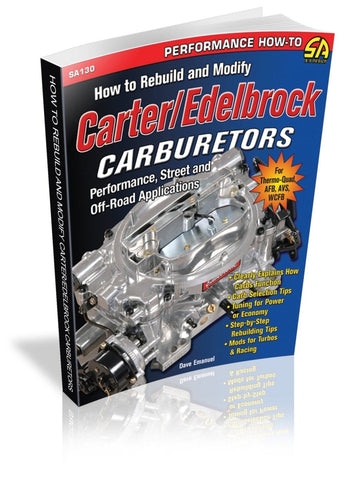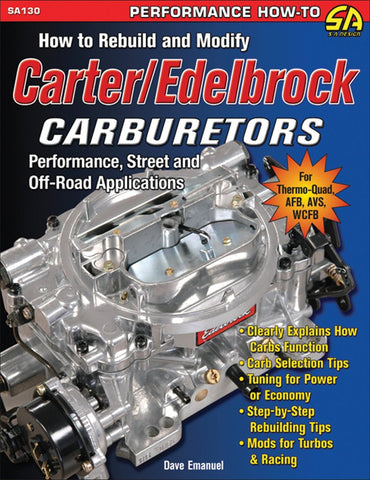If you want to modify your carburetor-equipped vehicle for performance today, you can choose from three major carburetor families - Holley, Demon, and Edelbrock. While Holley and Holley-style carburetors like Demon have been popular for years with their well documented successes and quirks, there has never before been a book covering the ins and outs of the emerging Edelbrock line of carburetors.
How to Rebuild and Modify Carter/Edelbrock Carburetors reflects the emergence of Edelbrock carburetors as the predominant Carter-style carburetors in the market today. A revision of the best-selling title Super Tuning and Modifying Carter Carburetors, this book contains more than 300 black and white photos, illustrations, and diagrams, covering rebuilding, tuning, and modifying Carter and Edelbrock carburetors.
This book also features the history of Carter as well as the history of the AFB and the AVS since the purchase by Edelbrock. Author David Emanuel outlines carburetor types, gives a thorough look at carb selection and carb function, and offers detailed information on modifications, tuning, and rebuilding Carter/Edelbrock carburetors.
Chapter 1: In the Beginning
From Tinkerer to Manufacturer
The Four-Barrel Era
Chapter 2: Carburetor Types
Basic Carter Models
The WFCB
The Original AFB
The Late-Model Carter AFB
The Carter AVS
The Thermo-Quad
The BBD Two-Barrel
Edelbrock Carburetors
Performer (AFB) Series
Thunder AVS Series
Chapter 3: Carburetor Selection
How Big?
How to Determine Flow Requirements
Airflow: Ratings vs. Reality
A Question of Efficiency
Air Valve Secondaries
Carb/Manifold/Cam: A Meaningful Relationship
Real Life and Other Considerations
Chapter 4: Carburetor Function
Edelbrock/Carter Complexity
Back to Basics
Pressure of Vacuum?
Mr. Venturi and His Pressure Dropper
When Air Meets Gas
Let it Bleed
Booster Venturis—For a Stronger Signal
Appearance vs. Reality
Jets—The Keys to Mixture Control
Power Enrichment Circuit
Economizer or Powersizer?
Spare the Rods
Multi-Stage Enrichment for Optimum Economy
Accelerator Pump Circuit
Bridging the Gap
Engine Load & the Pump Circuit
Piston vs. Diaphram
Idle System
Idle Circuit Function and Calibration
Making the Adjustment
Turn, Turn, Turn
A Free Transfer
Chokes and Cold Starting
Integral, Divorced, Electric: Solutions to a Choking Situation
Secondary Metering Systems
The Secondary Idle Circuit
Secondary Main Metering
Vacuum Secondary Actuation
Air Valve Secondaries
Mechanical Secondaries
Fuel Inlet Control
Float Bowls
Setting of Fuel Level
Chapter 5: Carburetor Modifications
Why Modify?
Primary Idle System
Modifications: When and Where?
Adjustable Air Bleed Idle Systems
Main Metering System
Major Modifications
Jets and Metering Rods
Spare the Rod, Spoil the Carb?
Power Enrichment
A Matter of Timing
Discretion: The Better Part of Valor
Tuning the Accelerator Pump
Change the Nozzle, Alter the Rate
Secondary Main Metering Systems
Numbering System: There’s Logic Somewhere
Secondary Actuation
Air Valve Adjustment
Fuel Inlet System
Racing Modifications
A Little Here, A Little There
A Little More Here, A Little More There
More Fuel for the Fire
Dual Feed
Fine Tuning
Power Enrichment
Secondary Timing
Chapter 6: Carburetor Tuning
General Tuning Tips
Street Tuning
Economy: An Overview
Tuning for High Altitude
Tuning for Turbo and Supercharging
Tuning for Off-Road
Maintenance
Avoiding Vacuum Leaks
Chapter 7: Rebuilding Tips
Thermo-Quad Rebuilding Tips
Disassembly
Assembly and Adjustments
AVS Rebuilding Tips
Disassembly
Adjustments After Rebuilding
AFB Rebuilding Tips
Disassembly
Adjustments
WFCB Rebuilding Tips
Appendix
Thermo-Quad Exploded View
AVS Exploded View
AFB Exploded View
WFCB Exploded View
If you want to modify your carburetor-equipped vehicle for performance today, you can choose from three major carburetor families - Holley, Demon, and Edelbrock. While Holley and Holley-style carburetors like Demon have been popular for years with their well documented successes and quirks, there has never before been a book covering the ins and outs of the emerging Edelbrock line of carburetors.
How to Rebuild and Modify Carter/Edelbrock Carburetors reflects the emergence of Edelbrock carburetors as the predominant Carter-style carburetors in the market today. A revision of the best-selling title Super Tuning and Modifying Carter Carburetors, this book contains more than 300 black and white photos, illustrations, and diagrams, covering rebuilding, tuning, and modifying Carter and Edelbrock carburetors.
This book also features the history of Carter as well as the history of the AFB and the AVS since the purchase by Edelbrock. Author David Emanuel outlines carburetor types, gives a thorough look at carb selection and carb function, and offers detailed information on modifications, tuning, and rebuilding Carter/Edelbrock carburetors.
Chapter 1: In the Beginning
From Tinkerer to Manufacturer
The Four-Barrel Era
Chapter 2: Carburetor Types
Basic Carter Models
The WFCB
The Original AFB
The Late-Model Carter AFB
The Carter AVS
The Thermo-Quad
The BBD Two-Barrel
Edelbrock Carburetors
Performer (AFB) Series
Thunder AVS Series
Chapter 3: Carburetor Selection
How Big?
How to Determine Flow Requirements
Airflow: Ratings vs. Reality
A Question of Efficiency
Air Valve Secondaries
Carb/Manifold/Cam: A Meaningful Relationship
Real Life and Other Considerations
Chapter 4: Carburetor Function
Edelbrock/Carter Complexity
Back to Basics
Pressure of Vacuum?
Mr. Venturi and His Pressure Dropper
When Air Meets Gas
Let it Bleed
Booster Venturis—For a Stronger Signal
Appearance vs. Reality
Jets—The Keys to Mixture Control
Power Enrichment Circuit
Economizer or Powersizer?
Spare the Rods
Multi-Stage Enrichment for Optimum Economy
Accelerator Pump Circuit
Bridging the Gap
Engine Load & the Pump Circuit
Piston vs. Diaphram
Idle System
Idle Circuit Function and Calibration
Making the Adjustment
Turn, Turn, Turn
A Free Transfer
Chokes and Cold Starting
Integral, Divorced, Electric: Solutions to a Choking Situation
Secondary Metering Systems
The Secondary Idle Circuit
Secondary Main Metering
Vacuum Secondary Actuation
Air Valve Secondaries
Mechanical Secondaries
Fuel Inlet Control
Float Bowls
Setting of Fuel Level
Chapter 5: Carburetor Modifications
Why Modify?
Primary Idle System
Modifications: When and Where?
Adjustable Air Bleed Idle Systems
Main Metering System
Major Modifications
Jets and Metering Rods
Spare the Rod, Spoil the Carb?
Power Enrichment
A Matter of Timing
Discretion: The Better Part of Valor
Tuning the Accelerator Pump
Change the Nozzle, Alter the Rate
Secondary Main Metering Systems
Numbering System: There’s Logic Somewhere
Secondary Actuation
Air Valve Adjustment
Fuel Inlet System
Racing Modifications
A Little Here, A Little There
A Little More Here, A Little More There
More Fuel for the Fire
Dual Feed
Fine Tuning
Power Enrichment
Secondary Timing
Chapter 6: Carburetor Tuning
General Tuning Tips
Street Tuning
Economy: An Overview
Tuning for High Altitude
Tuning for Turbo and Supercharging
Tuning for Off-Road
Maintenance
Avoiding Vacuum Leaks
Chapter 7: Rebuilding Tips
Thermo-Quad Rebuilding Tips
Disassembly
Assembly and Adjustments
AVS Rebuilding Tips
Disassembly
Adjustments After Rebuilding
AFB Rebuilding Tips
Disassembly
Adjustments
WFCB Rebuilding Tips
Appendix
Thermo-Quad Exploded View
AVS Exploded View
AFB Exploded View
WFCB Exploded View










